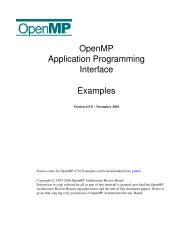D2 3 Computing e-Infrastructure cost calculations and business _models_vam1-final
D2 3 Computing e-Infrastructure cost calculations and business _models_vam1-final
D2 3 Computing e-Infrastructure cost calculations and business _models_vam1-final
Create successful ePaper yourself
Turn your PDF publications into a flip-book with our unique Google optimized e-Paper software.
e-‐FISCAL: www.efiscal.eu <br />
EC Contract Number: 283449 <br />
2. State of the Art<br />
The state of the art review was initiated as the first step within the project <strong>and</strong> continued throughout the lifetime <br />
of the project. It included review of publications in several domains, such as <strong>cost</strong>ing <strong>models</strong> for e-‐<strong>Infrastructure</strong>s, <br />
cloud computing, <strong>business</strong> <strong>models</strong> <strong>and</strong> Green IT. However, <strong>cost</strong>ing <strong>models</strong> for e-‐<strong>Infrastructure</strong>s <strong>and</strong> cloud <br />
computing did have the most direct link with the core research question, hence publications in those domains <br />
have been reviewed most extensively. <br />
The state of the art review was conducted through usual desk research methods <strong>and</strong> by attempting to contact <br />
authors of the papers found in order to see if they had additional suggestions. This engagement with the authors <br />
produced additional references. The desk research was aimed at finding relevant project reports, conference <br />
papers, academic papers (accessed through university subscriptions), Internet articles, professional reports, etc. <br />
The relevant documents reviewed are published in the state of the art repository (http://www.efiscal.eu/state-‐of-the-‐art).<br />
At the end of the project the e-‐FISCAL repository counts 50 references. <br />
2.1 Costing <strong>models</strong><br />
The review of the state of the art revealed several categories of studies relevant to our project under the lens of <br />
<strong>cost</strong>ing <strong>models</strong> which are explained below. <br />
2.1.1 Cost categories<br />
A first category of papers deals with the typical <strong>cost</strong> categories that should be included when analysing the <strong>cost</strong> of <br />
computing e-‐<strong>Infrastructure</strong>s. The review of the state-‐of-‐art-‐literature revealed that there is a rather common <br />
break down of HTC/HPC <strong>cost</strong>s into the following categories: 1) computing <strong>and</strong> storage hardware <strong>cost</strong>s including <br />
interconnection <strong>cost</strong>s, 2) auxiliary equipment <strong>cost</strong>s (cooling, UPS, power generator), 3) software <strong>cost</strong>s, 4) <br />
personnel <strong>cost</strong>s, 5) site operating <strong>cost</strong>s (including electricity <strong>and</strong> premises <strong>cost</strong>s) <strong>and</strong> 6) connection <strong>cost</strong>s. This <strong>cost</strong> <br />
breakdown is stated in Opitz et al (2008) <strong>and</strong> has been repetitively adopted in several other studies. Kashef <strong>and</strong> <br />
Altmann (2012) review several papers <strong>and</strong> propose a similar categorization as that of Opitz et al. (2008). These <br />
<strong>cost</strong> categories fall within two main <strong>cost</strong> distinctions: Capital Expenditures (CAPEX) <strong>and</strong> operating expenses <br />
(OPEX). Capital Expenditures are incurred in order to create future benefits e.g. assets acquired have a useful life <br />
beyond one year. The <strong>cost</strong> is accounted for during the periods the assets are economically used through <br />
depreciation. Operating expenses refer to expenses incurred in the ordinary course of <strong>business</strong>, such as salaries, <br />
administration <strong>and</strong> selling expenses, energy expenses, overhead, etc. These expenses are considered <strong>cost</strong>s when <br />
they incur. 360 Intersect in the HPC Budget Allocation Map -‐Willard et al (2013)-‐ have also very similar <br />
categorization although naming may vary slightly. <br />
2.1.2 Costing methodologies<br />
A second category of papers dealt with the <strong>cost</strong>ing methodology to be applied in order to calculate yearly <strong>cost</strong>s. <br />
There are several <strong>cost</strong> accounting methodologies in order to perform a <strong>cost</strong>ing exercise e.g. activity based <strong>cost</strong>ing, <br />
life cycle <strong>cost</strong>ing 14 , total <strong>cost</strong> of ownership (TCO) 15 , full <strong>cost</strong> accounting (FCA) 16 , etc. Generally speaking, selection <br />
14 Life Cycle <strong>cost</strong>ing is a tool to calculate the economic <strong>cost</strong>s caused by a product or a service during its entire life cycle, from <br />
purchase of raw material <strong>and</strong> components, <strong>cost</strong> of production <strong>and</strong> investments to usage, maintenance <strong>and</strong> waste <br />
management. EU had commissioned the development of elaborated guidance on the application of life cycle <strong>cost</strong>ing <strong>and</strong> on <br />
e-‐FISCAL : Financial Study for Sustainable <strong>Computing</strong> e-‐<strong>Infrastructure</strong>s <br />
Deliverable <strong>D2</strong>.3 – <strong>Computing</strong> e-‐<strong>Infrastructure</strong>s <strong>cost</strong> estimation <strong>and</strong> analysis – Pricing <strong>and</strong> <br />
Business <strong>models</strong> <br />
21




